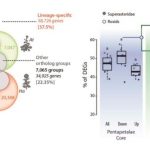Plantae Presents: Elizabeth Haswell and Naomi Nakayama
Due to the COVID-19 pandemic many seminar series and conferences have been canceled or postponed. In response to this, and to make sure plant scientists can continue to communicate their latest work to their peers, The American Society of Plant Biologists launched a virtual seminar series via our online community, Plantae. This is the 7th seminar in this new series, each of which features two speakers (read more). A list of upcoming seminars and recorded videos can be found here.

Elizabeth Haswell: Mechanosensitive ion channels in the green lineage
Liz Haswell a Professor and HHMI Scholar at Washington University in Saint Louis. She was an undergraduate at the University of Washington, did her PhD at UCSF, and completed postdoctoral studies at Caltech before moving to Wash U. She is a Senior Editor at The Plant Cell and, along with Ivan Baxter, co-hosts the TapRoot podcast. Her research focuses on the molecular mechanisms that underlie the perception and transduction of mechanical signals in plants. @ehaswell
 Naomi Nakayama: Forms and functions of the dandelion diaspore: how to fly and tune the flight
Naomi Nakayama: Forms and functions of the dandelion diaspore: how to fly and tune the flight
Naomi Nakayama is a senior lecturer in the Department of Bioengineering at Imperial College, London. She got her PhD in Molecular, Cellular, and Developmental Biology at Yale University, and was a postdoc at , a Chancellor’s Fellow at the University of Edinburgh and is now a group leader and Royal Society University Research Fellow at Imperial. Her work is very interdisciplinary and research in her Biological Form + Function group looks at a variety of plant systems, from trees to seeds, to understand how plants sense and respond to living signals and the resilience of living architecture. Naomi was recently profiled in New Phytoloigst. @nakayama_naomi
Moderated by Madeleine Seale
Madeleine Seale is a Leverhulme Early Career Fellow, University of Oxford, who studies how changes in water status affect the biomechanics of bryophytes focusing on how mechanical forces affect cell wall integrity and tissue morphogenesis. She is also a Plant Physiology Assistant Features Editor. @MaddySeale
Additional Q&A with Liz Haswell
I have a technical question! What kind of perfusion system did you use for injection during ca2+ signal recording?
- We used a TECAN plate reader with an automated injection system.
Which part of the plant in a mature period, is the most area you can detect this expression (msl10 gene)? Is it possible to find in anther development?
- MSL10 seems to be expressed at low levels everywhere, based on publicly available expression databases. GUS reporter lines show a strong signal in the vasculature of leaves and roots. MSL10 is not expressed in the anthers, but its homolog MSL8 is (see Hamilton et al., 2015)
I’d think that a mechano-sensitive sensor could not only react to cell swelling but also to touch. How were the experiments designed to make sure no touch or other outside forces might trigger the MSL10-mediated responses?
- Our main control for this was using iso-osmotic treatments. In this case, we did not see any of the downstream signals that were present when seedlings were presented with hypoosmotic shocks.
What about MSL10 interacting partners? Do you have any clue?
- We have done a large number of screens and have a ton of candidates, but none are yet validated by genetics. Stay tuned!
Is there some type of dose-response effect, meaning more pressure means more response?
- We haven’t done this experiment yet, but we definitely should.
Does the activity of MSL10 generate any developmental plant response in terms of morphogenesis?
- Yes, gain-of-function mutation in MSL10 or MSL10-YFP overexpression leads to dwarfing and the appearance of dead patches on leaves of mature, soli-grown plants. You can see some pictures in Veley et al., 2014 and Basu et al., 2020.
Thank you for your talk. Do the plants mutant in msl10 / MSL10 gain of function have any phenotype in arabidopsis seedling roots?
- You are welcome! No, we do not see any differences in seedling roots between genotypes. We tested to see if growth rate on normal media or on mannitol or PEG was different and it was not.
Can MS ion channels directly interact with other proteins through cytoplasmic domain?
- We think so! We know that the soluble N- and soluble C-terminus of MSL10 interact, and presumable there are other proteins that the N-terminus interacts with in order to execute its signaling, but we have not yet identified those proteins.
Why is TCH response in the two msl mutant lines under hypo-osmotic so different?
- one of those alleles, msl10-1 is a loss-of-function T-DNA insertion. Presumably, no functional protein is made from this allele. The other, msl10-3G, is a point mutation that has a gain-of-function phenotype, presumably due to an over-active protein being made.
Is there tissue specificity for the MSL? and is there a threshold pressure for the channel to start work?
- MSL10 seems to be expressed at low levels everywhere, based on publicly available expression databases. GUS reporter lines show a strong signal in the vasculature of leaves and roots. Yes, there is a threshold pressure for the channel to be activated. The exact pressure depends on the geometry of the patch, but it is likely to be around 5 mN/m based on comparison to its homolog in E. coli, MscS.
Hello, I want to know if these mechanosensitive ion channels mediate Mimosa pudica’s response….thank you, excellent presentation
- Good question! It does seem likely! But without a mutant library, it is hard to know the answer. Thank you for your kind words.
Have you tested if the msl10 KO affect GA morphology changes? As GA affects cell expansion.
- We have not looked at this–it is a great suggestion!
I am wondering if any kind of toxicity in the soil like aluminum toxicity might affect mechanosensitive channel activity in roots??
- Another good question. I don’t know the answer to this. It would be interesting to test!
There are also many other stimuli that trigger Ca, ROS, WRKY18 expression, and PCD, such as Pst infection. How much is the MSL10-mediated induction of these responses specific to mechanostresses?
- This is very true. We are working now to understand exactly this question.
Are MSL mutants affected in their root ability to penetrate the soil and explore it?
- Not that we have observed.
Great talk! the question about cell type, vacuole type. Cell swelling occurred in the cells with lytic vacuole and accompanied by changes in vacuolar pH and transport through tonoplast. Did you consider this?
- Thank you! In this project so far, we have been evaluating either entire seedlings, or the elongation zone of the root (depending on the assay). It would be very interesting to correlate what we see at the cellular level with TUNEL assays and vacuole type. maybe we can use our dex-inducible MSL10 lines to look at the effect in these cell types
Are there mechanosensitive channel families not found in plants? What are they?
- There is a family of MS ion channels that is specific to the mammalian inner ear that mediates hearing (TMC1), and another type that is responsible for the perception of gentle touch in worms (DegENaC). TRP channels are also responsible for the taste of hot chilis!
Is it possible that reactive oxygen species are not exported in the mutant in response to pathogen attack?
- Yes, definitely possible! We’ll have to
Is it known which type of mechanosensitive ion channels functions in gravity sensing?
- There is a recent paper from the Iida lab implicating the MCA family in the perception of hypergravity–it’s in Plants
Would you expect the force caused by a penetrating haustoria to invoke a similar stress to osmosis induced swelling?
- Not necessarily, it might be more localized and might develop more slowly.
is there any known mechanosensitive channel specific to the nucleus that directly regulate gene expression?
- Not known, but that would be incredible! There is some evidence for channels that control nuclear calcium signaling, but it is far from established.
Can you expand on the role of phosphorylation in MSL10 regulation?
- Phosphorylation of the MSL10 N-terminus seems to be the default state, and dephosphorylation required for MSL10 to signal (see Veley et al., 2014; Basu et al., 2020). In the assay I described here, we showed that phospho-dead versions of MSL10 were unable to produce downstream signaling after cell swelling.
Could bacterial resistance be due to Calcium signaling?
- Yes, it could–we are looking into all options.
Do you have a question? Share your comments and thoughts below!






Leave a Reply
Want to join the discussion?Feel free to contribute!